
Topics
Guests
- Keith LaMarartist, teacher and writer currently serving time on death row in Ohio. He is scheduled for execution in 2027.
- Keegan Stephancivil rights lawyer.
We speak with death row inmate Keith LaMar live from the Ohio State Penitentiary, after the release of The Injustice of Justice, a short film about his case that just won the grand prize for best animated short film at the Golden State Film Festival. “I had to find out the hard way that in order for my life to be mine, that I had to stand up and claim it,” says LaMar, who has always maintained his innocence. LaMar was sentenced to death for participating in the murder of five fellow prisoners during a 1993 prison uprising. His trial was held in a remote Ohio community before an all-white jury. On January 13, 2027, the state intends to execute him, after subjecting him to three decades in solitary confinement. LaMar’s lawyer, Keegan Stephan, says his legal team has “discovered a lot of new evidence supporting Keith’s innocence” that should necessitate new legal avenues for LaMar to overturn the conviction.
Transcript
AMY GOODMAN: This is Democracy Now!, democracynow.org. I’m Amy Goodman.
We end today’s show with an incredible new animated short film. It’s called The Injustice of Justice. It’s illustrated by the world-renowned artist Molly Crabapple and is narrated and written by a man on Ohio’s death row, Keith LaMar. Keith LaMar will join us live from death row in a moment.
He has long maintained he was wrongfully convicted, and is fighting his pending execution. The Injustice of Justice just won the grand prize for the best animated short film at the Golden State Film Festival. Keith LaMar made history by being the first-ever death row prisoner to call in to speak at his own film premiere and to engage the audience.
This is the full short film, in which LaMar describes how he found himself sentenced to death after the 1993 Lucasville prison uprising at the Southern Ohio Correctional Facility, where he was being held. This is The Injustice of Justice.
KEITH LAMAR: My name is Keith LaMar. I’m a poet, author and musician. For the past 31 years, I’ve been in solitary confinement, buried under the never-ending agony of sensory deprivation. On January the 13th, 2027, the state of Ohio intends to kill me. I’m innocent. Thousands of people around the country and the world have rallied around my cause, joining me in my demand for justice. Here’s my story.
When I was 19 years old and selling drugs, a group of would-be robbers in search of money forced their way into my apartment. A shootout ensued, and, regrettably, I took someone’s life and was myself shot twice in the legs. Facing a long prison sentence and on the advice of counsel, I pled guilty to murder and was sentenced to serve 18 years to life. Determined to redeem myself and make good on my potential, I completed my GED, enrolled in college and became a voracious reader in an attempt to repair myself to society.
I was in the fourth year of my sentence when, in 1993, a riot erupted inside the prison. Apparently, a group of Muslim prisoners on religious grounds refused to submit to mandatory tuberculosis testing and were given an ultimatum: Take the test or else. Amid rumors of a forced inoculation, the Muslims took over the prison in protest, releasing some 400 prisoners from their cells and setting into motion an 11-day standoff that would also reclaim the lives of one guard and nine prisoners.
I was on the recreation yard when it all began. A guard came running out of the building with blood streaming down his face, followed by a masked prisoner who was carrying a weapon and yelling, “We taking over!” Against my better judgment, I went inside to check on my personal belongings. A fatal mistake. It was complete chaos. When I made it to my assigned location, I discovered that it was being used as a holding area for hostages, both guards and prisoners. I was thereafter approached by a masked prisoner, who gave me the option to either participate or leave. I chose to leave.
Hundreds of us gathered on the yard, waiting as the National Guard and Highway Patrol took up watch outside the perimeter fence. Later, when dead bodies were dumped into the yard, they stood by and did nothing. It was as if I was trapped inside a nightmare.
Around 2 a.m. the following morning, we were rounded up and herded into the gymnasium, where we were stripped naked and then violently forced in random groups of 10 into cells meant for one person. Stressed and stretched to the limit, a fight broke out over food. Tragically, I stood back and watched as a man named Dennis Weaver was held down by three prisoners and choked to death. It was a cowardly thing to do. And I can now see and admit that. But at the time, I was worried about my own life. When I was later questioned by authorities, I claimed to have been asleep. It was my way of telling them that I didn’t want to be involved.
But it was too late. Because I had gone into the hostage area without wearing a mask, my name would be mentioned among the vast array of potential subjects. Even though the state concedes that I was never affiliated with any of the gangs said to have presided over the riot, the fact that I was already serving time for murder would play big part in their decision to indict me.
Ultimately, I was charged with nine counts of aggravated murder. I couldn’t believe it. Mind you, it was never expected that I would actually demand a trial. “He copped out once. He’ll cop out again” was the prevailing belief. In fact, no sooner than I was indicted, I was offered a deal: “Plead guilty, and we’ll run the time concurrent with the time you’re already serving.” In other words, I would have gotten off easier had I actually killed someone.
But why me? Why was I singled out for this undeserved retribution? It’s a good question, one that I’ve spent the better part of three decades trying to explain. Here’s what I can tell you. When the riot came to an end, overzealous officials rushed into the prison without first securing the massive crime scene, rendering inadmissible some 22,000 pieces of evidence. So there was absolutely no evidence to link anyone to crimes. This meant the state had to rely solely on the uncorroborated testimony of jailhouse informants, the most unreliable witnesses of all.
What to do? Well, the first thing the state did was enlist the help and expertise of the Hamilton County Prosecutor’s Office. This was not a random selection. Hamilton County has the dubious distinction of convicting and executing more than half of all death row prisoners in the United States. And how have they been so successful? The answer is simple and deadly: through the impaneling of all-white juries, the use of paid jailhouse informants and the intentional withholding of exculpatory evidence. I have now in my possession the statement of an actual perpetrator who admitted to murdering someone for whom I was sentenced to death. And this is only the tip of the iceberg. They withheld so much more.
It’s over three decades later now, and I’m still in solitary confinement being tortured because I refused to plead guilty to something I didn’t do. I’m innocent. Look, we kid ourselves when we speak of justice. Until we have a process that holds everyone equally accountable for their actions, this system will remain what it has always been: a punishment system. And as we all know, those who don’t have the capital get the punishment.
AMY GOODMAN: That’s the new, award-winning short film The Injustice of Justice, illustrated by the world-renowned artist Molly Crabapple, narrated and written by Keith LaMar, who’s fighting to raise awareness about his case on death row. He faces execution January of 2027. The film The Injustice of Justice just won the grand prize for the best animated short film at the Golden State Film Festival.
Keith LaMar has been held in prison for 36 years, 32 years in solitary confinement, 30 years on death row. His self-published memoir is Condemned: The Whole Story. He’s joining us now live from death row at Ohio State Penitentiary.
Welcome to Democracy Now!, Keith LaMar.
KEITH LAMAR: How are you? It’s such an honor and pleasure, I can tell you. And I’m not just speaking for myself, but for so many people who are inside. We have been listening to you for decades. And so, it’s quite an honor. Quite an honor. [inaudible]
AMY GOODMAN: Can you talk about the making of this film, explaining your case, and what you’re hoping to accomplish right now? You have made this film. You do live concerts that are performed around the world, remarkably, where you’re joining from death row. You have book clubs, where your own book is read, but where you also lead in discussion of other books, as well, with high schools and other places. Talk about your message, Keith.
KEITH LAMAR: Well, I, you know, from the very beginning, just wanted to stand on my innocence. You know, it was never really a matter of me not wanting to speak out, to stand up for myself, but that was the whole point of me demanding the trial. But the whole system, I soon found out, is centered around appearance around operating within prescribed parameters and whatnot. And I was advised to remain quiet during my trial and the day after, and I did. You know, I went along with it. You know, that’s what we do. And, you know, other smarter, more learned people would speak on my behalf, would stand up and fight for my life, you know, and I believed that. And I just kept going deeper and deeper into the darkness, until I found myself in this really, really desperate place where I was really standing on the brink of my existence. You know, I had to find out the hard way that in order for my life to be mine, that I had to stand up and fight it. You know, so that was really the thing that was the catalyst that pushed me to start speaking up and reaching to utilize my own agency. And all of these things that you just mentioned is a product of that general thrust, you know, that thing that’s just coming to the conclusion that if I don’t stand up right now, then I might lose my life.
And so, that was the thing that kind of started the movie. You know, I first started — I wrote the book that you mentioned, Condemned, and that was over 200 pages. And not long after that, a dear friend of mine, Lorry Swain, produced a documentary, which was 30 minutes. And so, we was trying to figure out a way to condense it even more, because, you know, of course, people have short attention spans. We understand — I understand that people have their own problems, have their own lives to live out. And so, you know, it’s asking a lot to ask someone to sit down and read a 200-some-page book or a 30-minute documentary. But we thought that if we could condense the story into a seven-minute short, then possibly that could garner more attention. So, that was the whole impetus behind creating the movie.
You know, my friend, my campaign manager, Amy Gordiejew, was at a museum [inaudible] in Alabama and saw a movie that Molly Crabapple had produced. And she had the idea from that that maybe this could be applied to my story and we can, you know, put forth a similar project. And we contacted Molly and her team, and, you know, was able to raise the funding through this very kind individual named David Roush. And, you know, next thing we know, we had a movie on our hands. And so, yeah, I’m really, really grateful for the whole process, for sure.
AMY GOODMAN: Keith LaMar, in your book Condemned about Bobby Sands, if you can explain who he is —
KEITH LAMAR: Yeah.
AMY GOODMAN: — his hunger strike, and how it inspired you to go on a hunger strike, which led to your case being known? I mean, you’ve been written about in The New York Times. You have jazz greats playing with you, supporting your cause.
KEITH LAMAR: Yeah. One of my friends, who I think you might know, named Staughton Lynd, was a famous historian, social activist. He, in the beginning, when I was first sentenced to death, was sent to death row, he somehow found his way into my life. And he sent me that book about Bobby Sands, Nothing But an Unfinished Song, written by Denis O’Hearn, who has since become a very close friend of mine. He sent me that book. And as I was reading it, it felt as if I was being sent a message. You know, I had been pleading with these people — it was going on 18 years — in a civil suit that was 18 years, all to no avail. And, you know, I was reading this book, and it was almost a last-ditch effort before I was about to give up.
And Bobby Sands and his comrade — Bobby Sands, for those who don’t know, was an Irish prisoner who, along with several of his comrades, went on a hunger strike in Ireland. And, you know, some of their demands were very basic, just to be treated as human beings, which, of course, resonated with me. And not long after I finished that book, I reached out to the author, Denis O’Hearn, and I wrote him. We struck up a correspondence. He came in to see me. We became really close friends.
And I decided to undergo a hunger — enact a hunger strike myself. I, along with several other prisoners here at the supermax, went on hunger strike. And after 18 years of not being able to break through court cases and all that, in 12 days of being on a hunger strike, I was sitting in a visitor room with my family. And that was like a seminal moment in my journey. It kind of taught me that if anything is going to change, you have to stand up and speak out on your own. And, you know, one of my literary heroes, Richard Wright, he wrote in his book Black Boy that if you speak out who you are, you will discover that you are not alone.
AMY GOODMAN: Keith LaMar —
KEITH LAMAR: And, you know, being in solitary confinement — mm-hmm?
AMY GOODMAN: I wanted to bring in your lawyer, Keegan Stephan. In one of Trump’s —
KEITH LAMAR: Yes.
AMY GOODMAN: — first executive orders, January 20th, was to restore the death penalty, Trump said, which includes the order that attorneys general — the attorney general ensures all states have necessary drugs. This is Keith’s second execution date. What is it? January 13th, 2027. If you can explain what happens right now in court, where the case stands in court, and the role of the Ohio governor, Mike DeWine, the position he has taken, since he, not Trump, would decide what happens, ultimately, to Keith LaMar?
KEEGAN STEPHAN: Yes. Hi, Amy. And thanks for elevating Keith’s case.
You know, Keith, unfortunately, exhausted his direct appeals long ago. The state courts and federal courts looked at his trial and determined, incorrectly, that there were no constitutional deficiencies, and upheld his conviction and his death sentence. I do think that any fair-minded jurist looking at his trial now would deem it unconstitutional and overturn his convictions.
Unfortunately, the only way back into court is to find newly discovered evidence. So, me and a team of attorneys have been reviewing all the records in his case and talking to witnesses for the last two years, trying to turn up newly discovered evidence. We have discovered a lot of new evidence supporting Keith’s innocence. You know, I started as a skeptic. I’m a prison abolitionist, definitely an abolitionist of the death penalty. It doesn’t matter to me if he’s guilty; he shouldn’t be put to death. But I can tell you, after looking at the record, talking to witnesses, there is no doubt in my mind that he is actually innocent.
And we are working to put together a motion based on the new evidence to get back into court so that we can prove his innocence before his execution date. Unfortunately, you know, there is very little justice in the justice system, as Keith has noted, so it’s going to take much more than just litigation. We need mass movements of people, you know, speaking out, acting out and pushing the governor to pause his execution once again to relitigate.
AMY GOODMAN: Let me give the last word to Keith LaMar. Keith, you’re scheduled to die January 13th, 2027, second execution date. First was for lack of drugs to inject into you. Your final message as — what is it? May 31st, you’re expected to have a concert at Joe’s Pub here. It’s your 56th birthday then.
KEITH LAMAR: Yes, that’s right. You know, I’ve been living under the dread of death, as you noted at the outset, for over three decades. So, it’s not dying. You know, I’ve already made peace with the fact that I’m going to die at some point and some day. All of us are. But the thing that really drives me is, I’m here: How can I live? You know, you referenced all the things that I’ve accomplished since being on death row. And all those things come from a desire just to live, because I’m alive. You know, I have these really amazing musicians come into my life: Albert Marquès, Arturo O’Farrill, Caroline Davis, Elsa Nilsson, you know, Samora Pinderhughes — all these beautiful people.
AMY GOODMAN: Keith, we’re going to have to leave it there, but we’re going to continue the conversation and post it online at democracynow.org. Keith LaMar, artist, teacher, writer, death row prisoner, speaking to us from the Ohio State Penitentiary in Youngstown. I’m Amy Goodman.

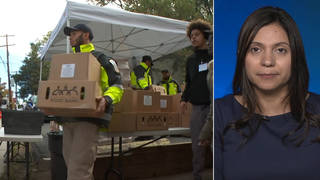


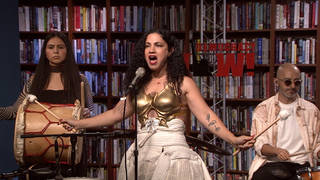
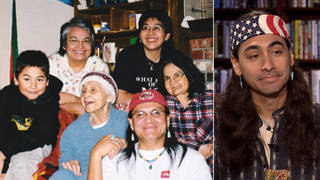
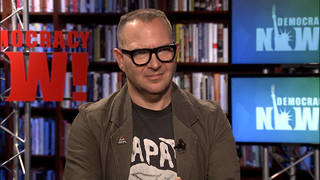
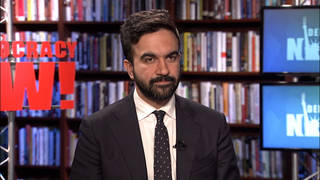
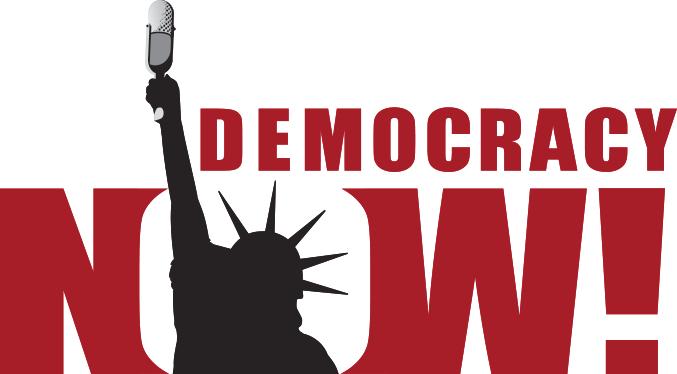

Media Options